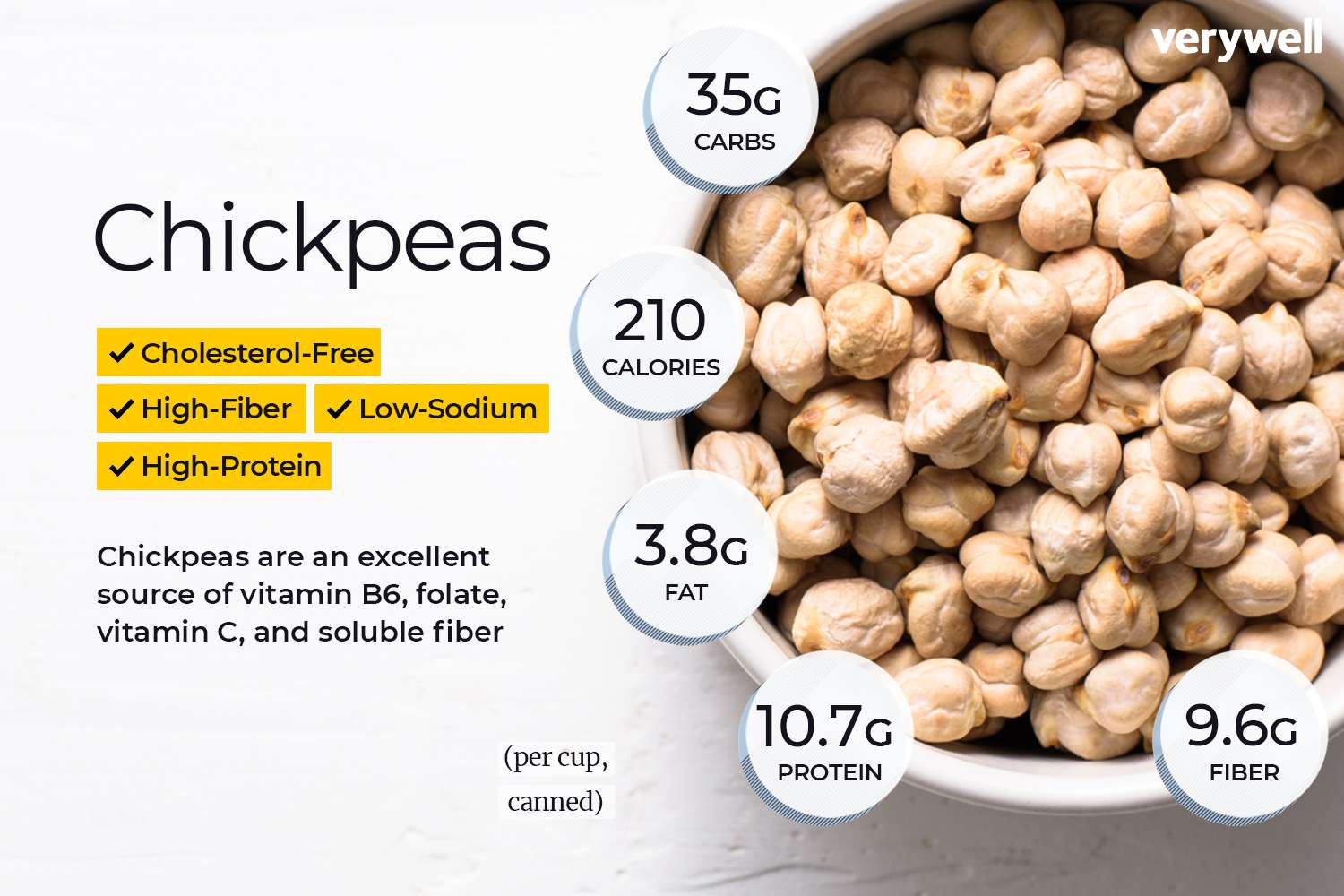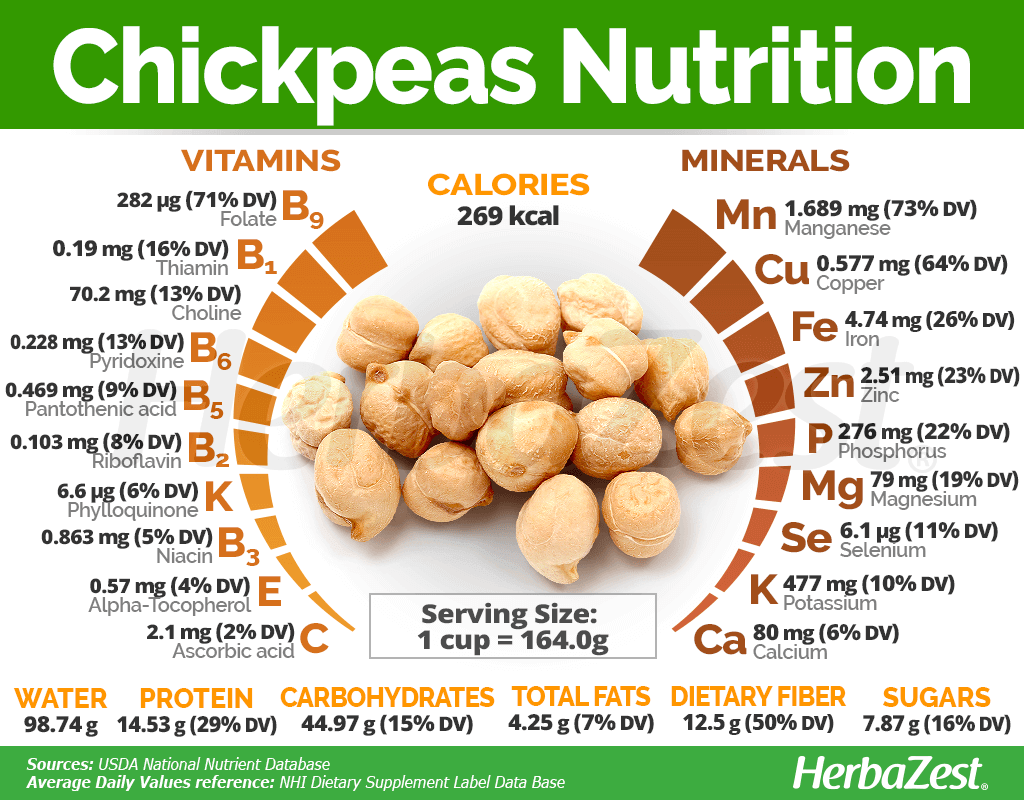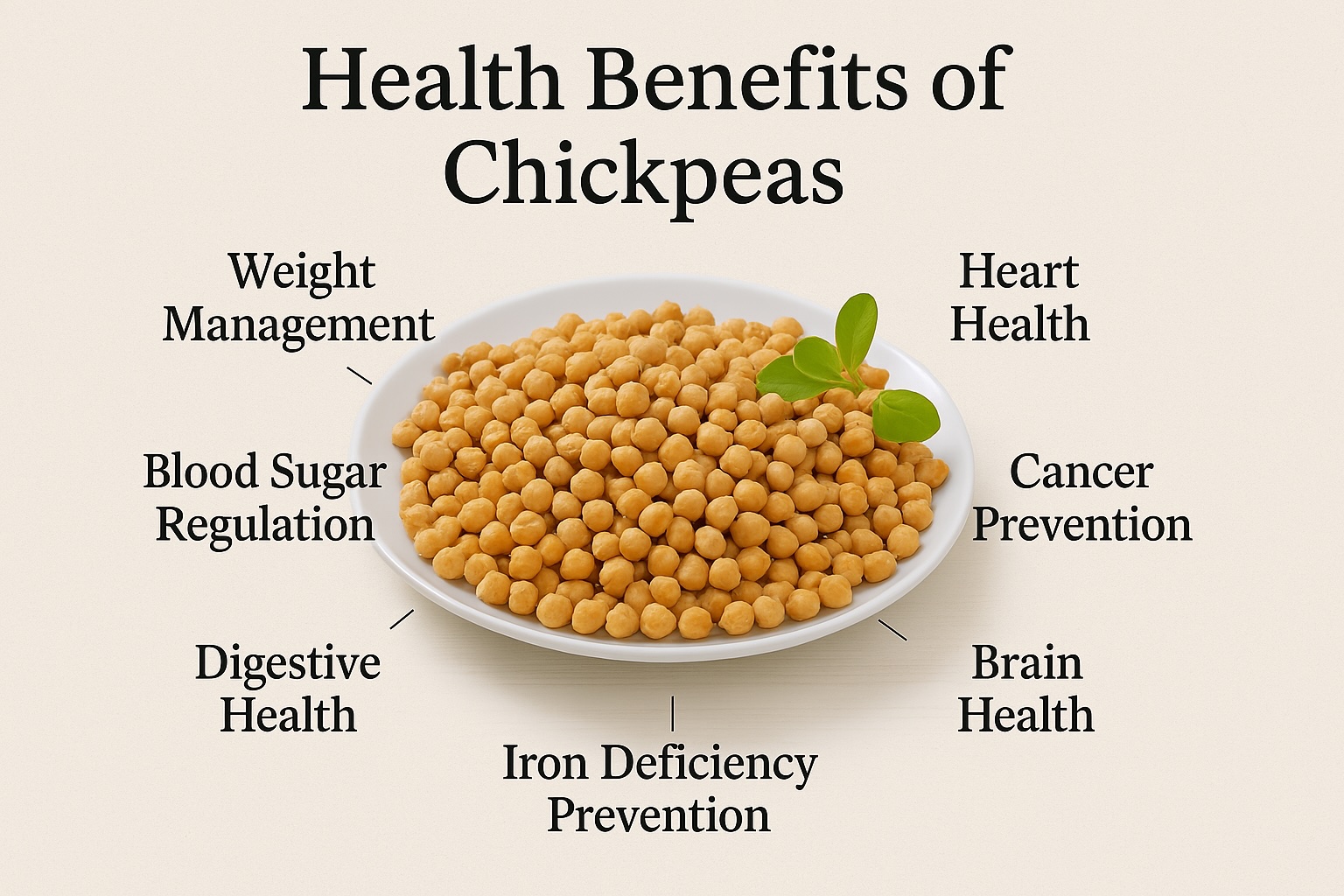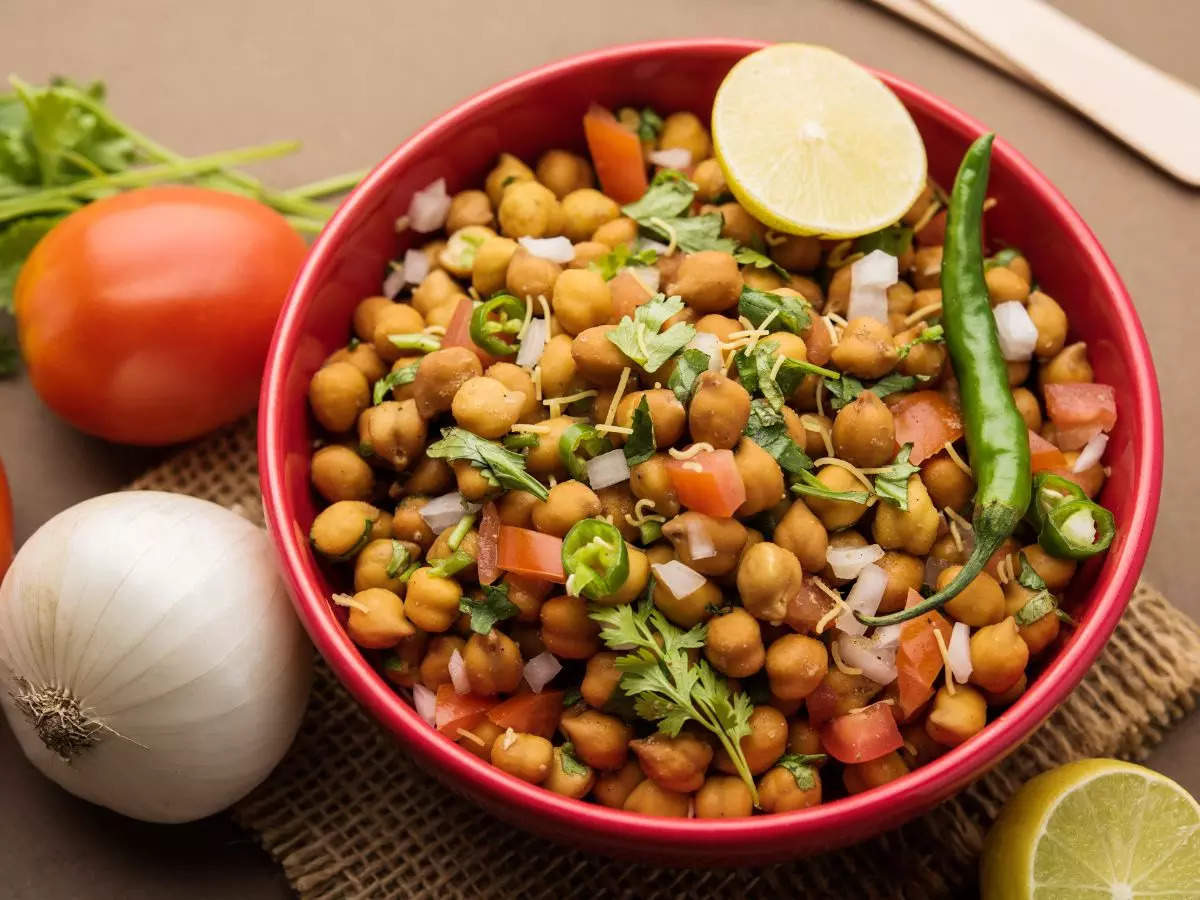Introduction to Chickpeas

Source: verywellfit.com
What Are Chickpeas?
Chickpeas, scientifically known as Cicer arietinum and commonly called garbanzo beans, are round, beige-colored legumes that belong to the legume family Fabaceae. [#1] These versatile legumes have a mild, nutty flavor and a firm texture that holds up well in various cooking methods. Unlike some other plant foods that might lack complete protein profiles, chickpeas offer substantial nutritional benefits comparable to certain vegetables like broccoli, though with different nutrient compositions.
The appearance of chickpeas varies slightly depending on the variety. Most commonly found in stores are the Kabuli chickpeas—larger, round, and light-colored. The Desi variety, smaller and darker with a rougher coat, is less common in Western markets but widely used throughout India and other parts of Asia.
History and Cultivation
Chickpeas have an impressive historical legacy, having been cultivated and consumed in Middle Eastern countries for thousands of years. [#2] Archaeological evidence suggests they were first domesticated around 7500 BCE in the Fertile Crescent region, making them one of the earliest cultivated legumes in human history.
From their Middle Eastern origins, chickpeas spread to India and the Mediterranean basin. Today, they’re grown worldwide, with major producers including India, Australia, Pakistan, Turkey, and several Mediterranean countries. Their ability to grow in semi-arid conditions makes them a valuable crop in regions with limited rainfall.
What’s particularly remarkable about chickpea cultivation is its sustainability profile. These plants have nitrogen-fixing capabilities, meaning they can convert atmospheric nitrogen into a form usable by plants. This natural process reduces the need for synthetic fertilizers and improves soil health, making chickpeas an environmentally friendly crop choice.
Chickpea Varieties
While most consumers are familiar with only one or two types of chickpeas, there are actually numerous varieties grown around the world. The two main categories include:
- Kabuli chickpeas: Larger, cream-colored beans with a smooth coat. These are the most common variety found in American and European markets, frequently used in Mediterranean and Middle Eastern cuisine.
- Desi chickpeas: Smaller, darker beans with a rough coat, higher in fiber than Kabuli varieties. These are predominantly used in Indian and Pakistani cooking.
Beyond these main categories, regional varieties offer subtle differences in flavor, size, and color. Black chickpeas (kala chana), green chickpeas (harvested young), and red varieties each bring distinct characteristics to different culinary traditions.
Fresh green chickpeas—harvested before maturity—offer a completely different experience from their dried counterparts. With a bright, slightly sweet flavor similar to fresh peas or edamame, they provide a seasonal delicacy in regions where chickpeas are grown.
Nutritional Profile of Chickpeas

Source: herbazest.com
Macronutrients
Chickpeas stand out as nutritional powerhouses in the legume family, offering an impressive balance of essential macronutrients. A single cup (164 grams) of cooked chickpeas delivers approximately 269 calories, making them a substantial yet reasonable addition to meals. This serving packs a remarkable 14.5 grams of protein, positioning chickpeas as an excellent plant-based protein source for vegetarians and vegans.
The fat content in chickpeas is relatively modest at 4 grams per cup, with most being heart-healthy unsaturated fats. This low-fat profile contributes to their status as a heart-friendly food option. Carbohydrates make up a significant portion of chickpeas’ nutritional makeup, with 45 grams per cup. However, unlike refined carbs that can spike blood sugar, chickpeas contain complex carbohydrates that digest slowly.
Perhaps most impressive is the fiber content—a substantial 12.5 grams per cup, representing nearly half of the daily recommended intake for adults. This fiber comes in both soluble and insoluble forms:
- Soluble fiber: Helps regulate blood cholesterol and glucose levels
- Insoluble fiber: Promotes digestive health and regular bowel movements
The protein in chickpeas contains most essential amino acids, though they’re slightly limited in methionine. Combining chickpeas with grains like rice or wheat creates a complete protein profile, which explains why traditional dishes like hummus with pita bread have stood the test of time across various cultures.
Vitamins and Minerals
Beyond macronutrients, chickpeas offer an impressive array of vitamins and minerals that support various bodily functions. The vitamin profile of chickpeas is particularly strong in B vitamins, including:
- Folate (B9): Essential for cell division and DNA synthesis, particularly important during pregnancy
- Vitamin B6: Supports brain development and function
- Thiamin (B1): Helps convert food into energy
- Riboflavin (B2): Important for growth and red blood cell production
The mineral content of chickpeas is equally impressive. They provide significant amounts of several key minerals:
- Iron: Critical for oxygen transport in the blood and energy production
- Phosphorus: Works with calcium to build strong bones and teeth
- Magnesium: Involved in over 300 biochemical reactions in the body
- Zinc: Supports immune function and wound healing
- Potassium: Helps maintain proper fluid balance and nerve transmission
- Manganese: Acts as an antioxidant and supports metabolism
- Copper: Assists with iron absorption and utilization
Chickpeas also contain small amounts of selenium, a powerful antioxidant that helps protect cells from damage. The combination of these minerals contributes to chickpeas’ role in supporting overall health, from bone strength to immune function.
What makes the nutritional profile of chickpeas particularly valuable is the bioavailability of these nutrients. While some plant foods contain compounds that can inhibit nutrient absorption, proper preparation methods like soaking and cooking chickpeas significantly reduces these anti-nutrients, allowing your body to access more of the beneficial components.
Compared to other legumes like lentils, chickpeas offer a similar nutritional package but with subtle differences in specific vitamin and mineral concentrations. This nutritional density, combined with their versatility in the kitchen, makes chickpeas a smart addition to a balanced diet.
Health Benefits of Chickpeas

Source: drpingel.com
The nutritional richness of chickpeas translates into numerous health benefits, making this legume a valuable addition to any diet. Research continues to uncover the many ways chickpeas can positively impact overall wellness.
Weight Management
Chickpeas can be a powerful ally in maintaining a healthy weight. Their high protein and fiber content creates a strong satiety effect, helping you feel full longer after meals. This natural appetite suppression may lead to reduced calorie intake throughout the day.
Studies show that regular chickpea consumers tend to have lower body mass indices (BMIs) and smaller waist circumferences compared to those who don’t eat them. The combination of protein and fiber works synergistically to slow digestion, stabilize blood sugar, and prevent the hunger spikes that often lead to overeating.
Additionally, research indicates that incorporating chickpeas and hummus into your diet may support weight management goals by improving portion control and reducing snacking on less nutritious foods. [#3]
Blood Sugar Regulation
For those concerned about blood glucose levels, chickpeas offer significant advantages. With a low glycemic index (GI) of approximately 28-32, chickpeas cause a slower, more gradual rise in blood sugar compared to high-GI foods.
The substantial fiber content in chickpeas plays a crucial role in this blood sugar regulation. Soluble fiber forms a gel-like substance in the digestive tract that slows carbohydrate absorption, preventing rapid spikes in glucose levels. This makes chickpeas particularly beneficial for people with diabetes or insulin resistance.
Research published in the Journal of Nutrition found that consuming chickpeas improved insulin sensitivity and glycemic control in participants. The amylose content in chickpeas—a type of resistant starch—further contributes to their blood sugar-friendly profile by resisting digestion in the small intestine.
Heart Health
Chickpeas offer multiple cardiovascular benefits that can help protect your heart. Their impressive content of magnesium and potassium works to regulate blood pressure—a key factor in heart disease prevention.
The soluble fiber in chickpeas binds to cholesterol in the digestive system, helping to remove it from the body before it can be absorbed into the bloodstream. This mechanism can lead to reduced LDL (bad) cholesterol levels while maintaining or increasing HDL (good) cholesterol.
Beyond fiber, chickpeas contain plant sterols and stanols that naturally block cholesterol absorption. Their low sodium and saturated fat content, combined with heart-healthy unsaturated fats, creates a cardiovascular-friendly nutritional profile that aligns perfectly with heart-healthy dietary recommendations.
Digestive Health
The digestive benefits of chickpeas stem primarily from their exceptional fiber content. With nearly 12.5 grams per cup, they provide both soluble and insoluble fiber types that support gut health in different ways:
- Soluble fiber feeds beneficial gut bacteria, promoting a healthy microbiome
- Insoluble fiber adds bulk to stool and speeds transit time through the digestive tract
- Both fiber types help prevent constipation and maintain regular bowel movements
Chickpeas also contain resistant starch, which functions similarly to fiber and serves as a prebiotic—food for the beneficial bacteria in your gut. As these bacteria ferment the resistant starch, they produce short-chain fatty acids like butyrate, which nourishes colon cells and reduces inflammation in the digestive tract.
Regular consumption of chickpeas has been linked to improved bowel function and reduced risk of digestive disorders, including diverticulitis and irritable bowel syndrome (IBS). However, some individuals may experience increased gas or bloating when first adding chickpeas to their diet—a temporary effect that typically subsides as the gut adapts.
Cancer Prevention
Emerging research suggests chickpeas may play a role in cancer prevention through multiple mechanisms. Their high fiber content supports colon health by speeding the removal of potential carcinogens from the digestive tract and feeding beneficial gut bacteria that produce protective compounds.
Chickpeas contain various phytochemicals with antioxidant and anti-inflammatory properties, including:
- Saponins: May inhibit tumor growth and prevent cancer cells from multiplying
- Lignans: Plant compounds with estrogen-like effects that may help prevent hormone-related cancers
- Phytic acid: Despite being considered an anti-nutrient in some contexts, has shown anti-cancer properties
The selenium and folate in chickpeas further contribute to their cancer-fighting potential. Selenium supports the immune system and helps prevent cellular damage, while folate plays a vital role in proper DNA synthesis and repair—processes crucial for cancer prevention.
Brain Health
Chickpeas offer several nutrients that support cognitive function and brain health. Their magnesium content helps regulate neurotransmitters involved in learning and memory, while B vitamins—particularly folate, B6, and choline—play essential roles in brain development and nervous system function.
The steady glucose release from chickpeas’ complex carbohydrates provides consistent energy to the brain, preventing the cognitive dips that can occur with blood sugar fluctuations. This steady energy supply is particularly important since the brain consumes approximately 20% of the body’s energy despite making up only 2% of its weight.
Additionally, the iron in chickpeas supports oxygen transport to the brain, which is critical for optimal cognitive performance. Iron deficiency, even without anemia, can impair attention, concentration, and memory—functions that adequate chickpea consumption may help maintain.
Iron Deficiency Prevention
With approximately 4.7 mg of iron per cup, chickpeas provide a significant portion of the daily iron requirement, especially for plant-based eaters. Iron plays a crucial role in oxygen transport throughout the body and energy production at the cellular level.
While plant-based (non-heme) iron is generally less bioavailable than animal-based (heme) iron, several strategies can enhance absorption from chickpeas:
- Consuming vitamin C-rich foods alongside chickpeas (like lemon juice in hummus)
- Proper preparation methods, including soaking and sprouting, which reduce phytates that can inhibit iron absorption
- Combining chickpeas with small amounts of heme iron sources for omnivores
For vegetarians, vegans, and others at risk of iron deficiency, chickpeas represent an accessible and versatile iron source that can help prevent the fatigue, weakness, and impaired immune function associated with low iron levels.
The diverse health benefits of chickpeas highlight why this ancient legume has remained a dietary staple across cultures for thousands of years. From supporting heart health to aiding digestion and potentially reducing cancer risk, chickpeas offer a remarkable range of advantages that extend far beyond their protein content.
Chickpeas in the Diet

source: timesofindia.indiatimes.com
Incorporating chickpeas into your daily meals offers a convenient way to boost protein, fiber, and essential nutrients. These versatile legumes can transform ordinary dishes into nutritional powerhouses with minimal effort.
How to Prepare Chickpeas
Chickpeas are available in both dried and canned forms, each with distinct advantages. Dried chickpeas are more economical and allow for complete control over flavor and texture, while canned varieties offer unmatched convenience.
When using dried chickpeas, proper preparation is key:
- Sort through the chickpeas to remove any debris or damaged beans
- Rinse thoroughly under cold water
- Soak for 8-12 hours or overnight to reduce cooking time and improve digestibility
- Drain and rinse again before cooking
- Simmer in fresh water for 1-2 hours until tender
Canned chickpeas provide a time-saving alternative without sacrificing nutritional value. Research indicates that canned chickpeas retain much of their nutritional profile and are comparable to dried cooked versions.
However, canned varieties often contain added sodium. To address this concern, draining and rinsing canned chickpeas can reduce up to 40% of excess sodium, making them a healthier option for those monitoring salt intake. [#4]
Serving Suggestions
Chickpeas shine in countless culinary applications across global cuisines. Their mild, nutty flavor adapts well to various seasonings and cooking methods:
- Roasted with spices for a crunchy, protein-rich snack
- Puréed into hummus with tahini, olive oil, and lemon
- Added to salads for extra protein and texture
- Incorporated into soups and stews for heartiness
- Ground into flour (chickpea flour or gram flour) for gluten-free baking
For a quick protein boost, keep a container of roasted chickpeas in your pantry. Season them with everything from simple salt and pepper to complex spice blends like za’atar or garam masala. These crunchy morsels make perfect desk snacks or salad toppers.
The liquid from canned chickpeas, known as aquafaba, has gained popularity as a remarkable egg substitute in vegan cooking. This previously discarded byproduct whips up similarly to egg whites and can be used in meringues, mousses, and baked goods.
Incorporating Chickpeas into Meals
Adding chickpeas to your meal rotation doesn’t require culinary expertise. Start with these simple integration strategies:
For breakfast, try chickpea flour pancakes or scrambles as protein-packed alternatives to traditional morning fare. Blend chickpeas into smoothies for added protein without altering the flavor profile significantly.
Lunch options abound with chickpea-based salads, wraps, and bowls. A Mediterranean-inspired bowl with chickpeas, fresh vegetables, feta, and olive oil provides a balanced meal rich in fiber and protein. For a quick desk lunch, mash chickpeas with avocado, lemon juice, and herbs as a sandwich filling.
Dinner possibilities include chickpea curries, stews, and pasta dishes. Replace half the meat in favorite recipes with chickpeas to reduce saturated fat while maintaining protein content. Chickpea-based veggie burgers offer a satisfying alternative to both meat and processed vegetarian options.
For families with children, chickpeas can be introduced gradually:
- Blend small amounts into familiar foods like pasta sauce or mashed potatoes
- Create fun shapes with chickpea patties
- Offer hummus as a dip for vegetable sticks or whole grain crackers
- Make chickpea chocolate chip cookies for a protein-boosted treat
Weekly meal prep becomes more efficient with batch-cooked chickpeas. Prepare a large quantity on weekends to use throughout the week in various dishes. This approach saves time while providing nutritional consistency across meals.
For those transitioning to more plant-based eating, chickpeas serve as an excellent bridge food. Their hearty texture satisfies meat eaters while delivering the nutritional advantages of legumes. Try chickpea tacos, chickpea “tuna” salad, or chickpea Bolognese sauce as familiar-format introductions.
The culinary flexibility of chickpeas makes them an ideal pantry staple for health-conscious cooks at any skill level. Whether you’re crafting gourmet meals or assembling quick weeknight dinners, these protein-packed legumes deserve a permanent place in your kitchen arsenal.
Potential Concerns and Considerations
While chickpeas offer impressive nutritional benefits, certain factors warrant attention before making them a dietary staple. Understanding these considerations helps maximize the advantages of this legume while minimizing potential drawbacks.
Allergies
Chickpeas belong to the legume family, alongside soybeans and peanuts, which rank among the most common food allergens. Individuals with known allergies to other legumes should exercise caution when introducing chickpeas into their diet.
Symptoms of chickpea allergies may include:
- Skin reactions such as hives or eczema
- Gastrointestinal distress including nausea, vomiting, or diarrhea
- Respiratory issues like wheezing or nasal congestion
- In severe cases, anaphylaxis – a potentially life-threatening reaction
Cross-reactivity between legumes exists but varies significantly among individuals. Some people allergic to peanuts may tolerate chickpeas without issue, while others might experience reactions to multiple legumes. If you suspect a chickpea allergy, consult with an allergist for proper testing and guidance.
Adverse Effects
Even for those without allergies, chickpeas can trigger digestive discomfort in some people. The high fiber content, while beneficial for overall health, may cause intestinal symptoms like gas, bloating, or abdominal pain, particularly when consumed in large amounts or when newly introduced to the diet.
These effects often stem from oligosaccharides – complex sugars that humans lack sufficient enzymes to digest fully. As these compounds reach the large intestine, gut bacteria ferment them, producing gas as a byproduct.
To minimize digestive discomfort:
- Start with small portions and gradually increase intake
- Thoroughly rinse canned chickpeas before use
- Soak dried chickpeas for at least 8 hours, discarding the soaking water
- Cook with digestion-friendly spices like cumin, fennel, or ginger
- Consider using sprouted chickpeas, which may be easier to digest
For individuals with irritable bowel syndrome (IBS) or similar conditions, chickpeas might trigger symptoms due to their FODMAP content. In such cases, portion control becomes particularly important, or alternative protein sources might be preferable.
Storage and Food Safety
Proper storage practices extend the shelf life of chickpeas while preserving their nutritional value and preventing foodborne illness.
Dried chickpeas demonstrate remarkable longevity when stored correctly:
- Keep in airtight containers in cool, dry locations
- Protect from direct sunlight and moisture
- When stored properly, dried chickpeas remain viable for 2-3 years
- Older chickpeas may require longer cooking times but remain safe to eat
Canned chickpeas typically maintain quality for 2-5 years, though checking expiration dates remains advisable. Once opened, transfer unused portions to non-metal containers and refrigerate for up to 4 days.
Cooked chickpeas require prompt refrigeration and should be consumed within 3-5 days. For longer storage, freezing offers an excellent option – frozen cooked chickpeas maintain quality for up to 6 months and can be thawed as needed for quick meal additions.
Food safety concerns with chickpeas primarily relate to improper preparation or storage. Undercooked chickpeas contain compounds that can cause digestive distress, while improperly stored cooked chickpeas may harbor harmful bacteria. Always cook dried chickpeas thoroughly and refrigerate leftovers within two hours of preparation.
For those consuming chickpea flour or products made with raw chickpea flour, be aware that heat treatment is necessary to neutralize anti-nutritional factors present in raw chickpeas. Commercial chickpea flour typically undergoes processing that addresses these concerns, but homemade versions should be properly heat-treated before consumption.
When incorporating chickpeas into a diet that includes nuts like cashews, be mindful of total protein intake and potential digestive effects from combining multiple high-fiber foods. Balance is key to avoiding discomfort while maximizing nutritional benefits.
Despite these considerations, chickpeas remain one of the most accessible, affordable, and nutritionally valuable plant proteins available. With appropriate preparation and consumption practices, most individuals can enjoy their benefits with minimal concerns.
Conclusion
Summary of Benefits
Chickpeas stand as a nutritional powerhouse in the plant-based protein landscape. These versatile legumes deliver an impressive array of health advantages while remaining accessible and affordable for most consumers worldwide. The nutritional profile of chickpeas makes them an exceptional addition to virtually any dietary pattern.
The protein content in chickpeas—approximately 15 grams per cup—provides essential amino acids that support muscle maintenance and growth. This makes them particularly valuable for vegetarians, vegans, and those reducing animal product consumption. Their protein quality, while not complete like animal sources, becomes comprehensive when paired with grains or nuts.
Beyond protein, chickpeas offer:
- Substantial dietary fiber (12-15 grams per cup) supporting digestive health and promoting satiety
- Complex carbohydrates that provide sustained energy without dramatic blood sugar fluctuations
- Heart-healthy fats that contribute to cardiovascular wellness
- Essential minerals including iron, zinc, phosphorus, and magnesium
- B vitamins that facilitate energy metabolism and nervous system function
The research-backed health benefits of regular chickpea consumption span multiple body systems. From blood sugar regulation and weight management to heart health protection and cancer risk reduction, these legumes contribute significantly to preventive health strategies. Their high fiber and moderate protein combination creates a nutritional profile that addresses several modern health challenges simultaneously.
Final Thoughts
Chickpeas represent an intersection of nutrition, culinary versatility, sustainability, and affordability rarely found in other foods. Their global presence across diverse culinary traditions—from Middle Eastern hummus to Indian chana masala to Mediterranean salads—speaks to their adaptability and universal appeal.
For those new to chickpeas, starting with familiar preparations like hummus or roasted chickpea snacks offers an accessible entry point. As comfort grows, experimenting with chickpea flour in baking or incorporating whole chickpeas into soups, stews, and salads can expand their presence in your diet.
While some individuals may experience digestive adjustment periods when increasing chickpea intake, most find that proper preparation techniques and gradual introduction minimize discomfort. The nutritional rewards typically outweigh these temporary challenges.
In a world increasingly concerned with sustainable protein sources, chickpeas shine brightly. Their cultivation requires significantly less water than animal protein production and contributes to soil health through nitrogen fixation. This environmental advantage adds another dimension to their appeal as a dietary staple.
Consider pairing chickpeas with vitamin C-rich foods like bell peppers or tomatoes to enhance iron absorption, or with zinc-containing foods to create nutritionally complementary meals. This strategic pairing approach maximizes the nutritional impact of each serving.
Whether you’re seeking to boost protein intake, manage weight, improve heart health, or simply diversify your diet with nutrient-dense options, chickpeas offer a solution that’s backed by centuries of traditional use and modern scientific validation. Their remarkable nutritional profile rivals that of other superfoods like pumpkin seeds, though they provide different specific benefits.
As research continues to explore the connections between diet and health, chickpeas consistently emerge as a beneficial dietary component worth incorporating regularly. Their combination of macro and micronutrients, along with bioactive compounds, positions them as a truly functional food capable of contributing to both immediate nourishment and long-term health outcomes.
By understanding both the benefits and considerations associated with chickpea consumption, you can make informed decisions about how to best incorporate this exceptional legume into your personal nutrition plan. Whether consumed daily or several times weekly, chickpeas represent one of nature’s most balanced and beneficial plant foods available to modern consumers.
References
- 1. Chickpeas (Garbanzo Beans) – The Nutrition Source
https://nutritionsource.hsph.harvard.edu/food-features/chickpeas-garbanzo-beans/ - 2. 10 Health and Nutrition Benefits of Chickpeas
https://www.healthline.com/nutrition/chickpeas-nutrition-benefits - 3. The Nutritional Value and Health Benefits of Chickpeas …
https://pmc.ncbi.nlm.nih.gov/articles/PMC5188421/ - 4. Chickpea Nutrition Facts and Health Benefits
https://www.verywellfit.com/chickpeas-nutrition-facts-calories-and-health-benefits-4118486